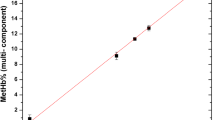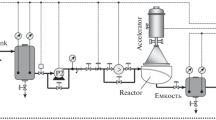Abstract
The effect of ionizing radiation on the iron-linked protein (haemoglobin) of the marine lamellibranchs Anadara granosa (Linn.) and Cardita antiquata (Lam.) from Bombay waters, India is discussed. Purified haemoglobin solutions were exposed to a 60Cobalt source delivering a dose of about 4,600 rad/min, at the sample irradiation point. Radiation damage or degradation was measured spectrophometrically by studying changes in the absorption spectra following irradiation in the presence and absence of oxygen. Exposure to ionizing radiation in general caused a decrease in absorption of both haemoglobins, irrespective of location, viz extra-versus intracellular, at Soret (412 mμ), β (540 to 42 mμ) and α (574 to 76 mμ) peaks, and an increase in absorption at 510 and 630 mμ. Upon exposure to a higher dose, O2Hb of C. antiquata showed an increase in absorption at the protein peak (280 mμ); exposure to a lower dose, however, resulted in decreased absorption. Furthermore, the changes following irradiation were dependent upon the initial state of the pigment. Oxyhaemoglobin, when exposed to radiation, oxidized to hemiglobin, and hemiglobin reduced to oxyhaemoglobin. The extracellular haemoglobin of high molecular weight (3x106) of the false cockle C. antiquata was found to be extremely radio-resistant, whereas intracellular haemoglobin of low molecular weight (74,000) of the arcid clam A. granosa was highly radiosensitive, since it could not be exposed to doses exceeding 18,000 r.
Similar content being viewed by others
Literature cited
Barron, E. S. G., J. Amrose and [P. Johnson: Studies on the mechanism of action of ionizing radiations. XIII. The effect of X-irradiation on some physico-chemical properties of amino acids and proteins. Radiat. Res. 2, 145–158 (1955).
—, Dickman, S., J. A. Muntz and [T. P. Singer: Studies on the mechanism of action of ionizing radiations. I. Inhibition of enzymes by X-rays. J. gen. Physiol. 32, 537–552 (1949).
— and [P. Johnson: Studies on the mechanism of ionizing radiations. XV. X-irradiation of oxyhaemoglobin and related compounds. Radiat. Res. 5, 290–302 (1956).
Collinson, E., F. S. Dainton and [B. Holmes: Inactivation of ribonuclease in dilute aqueous solutions. Nature, Lond. 165, 267–269 (1950).
Fricke, H.: The denaturation of protein by high frequency radiations. Cold Spring Harb. Symp. quant. Biol. 6, 164–170 (1938).
Kubota, M. and E. Watanabe: Effect of γ-irradiation of the structure of nucleic acid. I. Changes of components of nucleic acid. Bull. Jap. Soc. scient. Fish. 33, 769–774 (1967a).
— and E. Watanabe Effect of γ-irradiation of the structure of nucleic acid. II. Changes of deoxyribonucleic acid. Bull. Jap. Soc. scient. Fish. 33, 775–781 (1967b).
Lasser, H.: Effect of ionizing radiation on haemoglobin and cytochrome c. Nature, Lond. 176, 361–362 (1955).
McDonald, M. R.: The inactivation of dilute solutions of crystalline trypsin by X-radiation. I. Kinetics and characteristics. J. gen. Physiol. 38, 93–103 (1954).
— The inactivation of dilute solutions of crystalline trypsin by X-irradiation. II. Effects of enzyme concentration, medium pH and temperature. J. gen. Physiol. 38, 581–598 (1955).
Mee, L. K. and [G. Stein: The reduction of cytochrome c by free radicals in irradiated solutions. Biochem. J. 62, 377–380 (1958).
Moroson, H. and [P. Alexander: Changes produced by ultra violet light in the presence and in the absence of oxygen on the physico-chemical properties of deoxyribonucleic acids. Radiat. Res. 14, 24–49 (1961).
Patel, B. and [S. Patel: Studies on the haemoglobin of Anadara species. J. Anim. Morphol. Physiol. 11, 143–161 (1964).
Patel, S. and [B. Patel: Haemoglobin of marine bivalves Scapharca deyrollei (Jousseaume, 1893) and Cardita antiquata Lam. Proc. Symp. Mollusca (Mar. biol. Ass. India) 2, 584–594 (1968).
Rothschild, M. L., L. Cosi and [L. S. Meyers: Effect of gamma radiation of ferriprotoporphyrin. Nature, Lond. 192, p. 316 (1958).
Schubert, J.: Inadequacies in radiobiological experiments on medium effects. Int. J. Radiat. Biol. 13 (3), 297–300 (1967).
— and [W. Westfall: Effects of ionizing radiations and peroxide. Nature, Lond. 195, p. 1096 (1962).
Svedberg, J. and [S. Brohult: Splitting of the haemocyanin molecule by ultraviolet light. Nature, Lond. 142, p. 830 (1938).
Author information
Authors and Affiliations
Additional information
Communicated by N. K. Panikkar, Panaji
Rights and permissions
About this article
Cite this article
Patel, S., Patel, B. Effect of ionizing radiation on haemoglobin of marine lamellibranchs. Marine Biology 10, 272–279 (1971). https://doi.org/10.1007/BF00352818
Accepted:
Issue Date:
DOI: https://doi.org/10.1007/BF00352818




